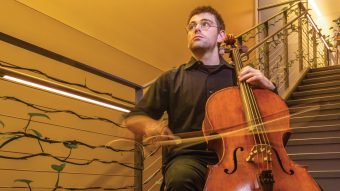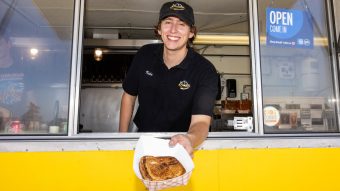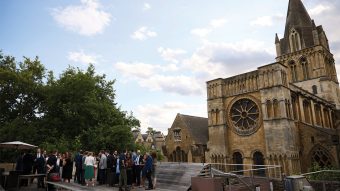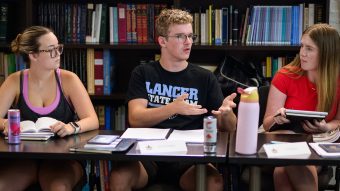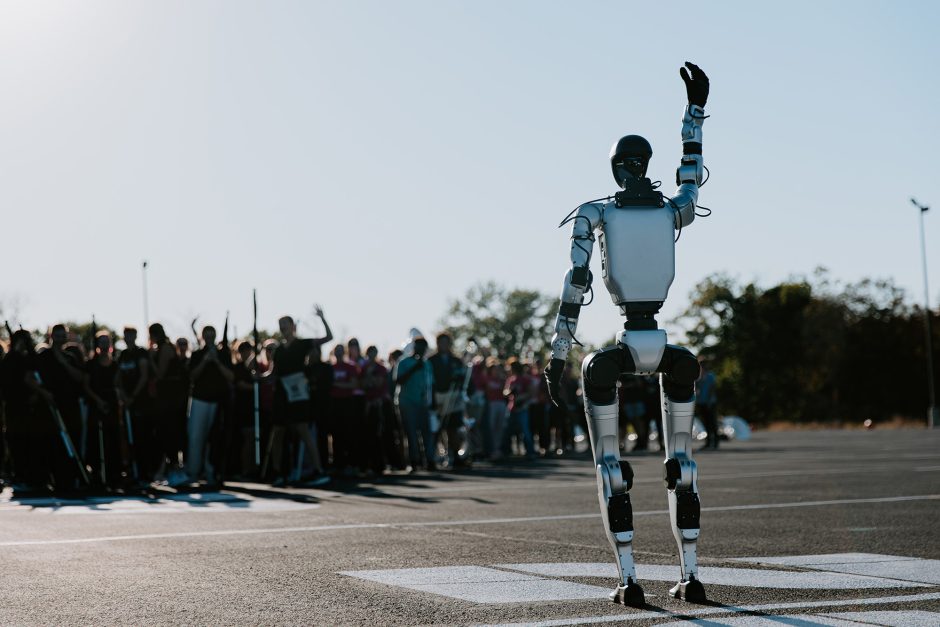
Nov. 8, 2025
Contact: Cary Littlejohn, carylittlejohn@missouri.edu
Photo by Kolden Lam
At the University of Missouri, innovation is built on tradition. In a collaboration between the College of Engineering and Marching Mizzou, a robot took the podium at Memorial Stadium — conducting the 140-year-old band in a first-of-its-kind performance.
“Grace” is a humanoid robot from Unitree Robotics that was purchased from Stokes Robotics in Carl Junction, Missouri. It suited up in the iconic black-and-gold uniform of the Big M of the Midwest and took the field for a halftime show titled “Digital Heartbeat,” a nod to Grace’s contribution to Marching Mizzou’s tradition of providing the heartbeat of every fall football Saturday in Columbia.
It’s a powerful example of Mizzou’s commitment to research excellence, collaborative spirit and pioneering breakthroughs.
The code behind the moves
Grace’s debut on Faurot Field may have come as a surprise to the nearly 60,000 fans in attendance, but it was a race to the finish for the computer science students — Van Grabner, Samantha Belano and Martín Leija — tasked with bringing it to life.
“At a 10,000-foot view, we are making the robot move in the way that the band wants it to move,” Grabner, a senior who’s been involved with robotics since he was a freshman, said.
That was easier said than done.
Grace — named for Grace Hopper, a pioneer in computer science — came to Mizzou’s Autonomous Systems Lab, which is run by Kristofferson Culmer, an assistant teaching professor in the College of Engineering, with very few capabilities straight out of the box.
That meant the Culmer’s students needed to code everything themselves.
Belano, a senior who joined Culmer’s lab last semester, decided to make the robot “dab” — the popular dance move — by coding the movements directly into it. It provided a template for the complex motions required for directing a band.
Any reasonably simple motion for a human becomes exponentially more difficult for a robot to perform.
“All of the sequences I constructed were derived from that code because the format worked for the dab,” Belano said. “The dab is a sequence of three poses instead of one, and the code interpolates through those to create smooth movement. That discovery made the way I approached the next sequences much easier because I knew I had to break the dances into poses and then iterate through them.”
Belano said it took two or three days of poring over the code base, deciphering diagrams that highlighted how different joints would move and then experimenting with changing small variables and tracking how the robot responded.
“That is something that every software developer will do for their entire career,” Grabner said. “Having the skills to pick up a code base that you’re unfamiliar with and learn it quickly and then make a product out of it is about half of a software developer’s job description.”
Even things that Grace knew how to do out of the box — namely walking — had to be reconsidered and adapted before the robot could take the field.
Leija, a senior and fifth-year member of Marching Mizzou, was tasked with putting the robot through its paces when it came to marching.
Grace, at about 4 feet, 4 inches tall, has a much shorter stride than most band members, so Leija’s mixture of marching band and engineering knowledge made him the perfect person to work on coding the robot’s lower body to ensure it was marching in step with the band.
Leija worked backward from possible failures to improve technical elements necessary for a successful performance. He fine-tuned details such as increasing step height to adjust for marching on turf and widening stances to improve balance.
Every facet of preparation for the show was an opportunity for the students to learn by doing — a hallmark of a Mizzou education known as the Missouri Method.
Partnerships that power possibility
Mizzou doesn’t simply make such collaborations possible; it actively encourages them, said Amy Knopps, associate director of bands and director of athletic bands in the College of Arts and Science’s School of Music.
“We are surrounded by remarkable talent across campus, and it is a privilege to join with others who bring their own artistry and expertise to a shared vision,” Knopps said.
It’s not the first time the band has shared the spotlight with a robot on Faurot Field. Back in 2021, Marching Mizzou welcomed Spot, the four-legged robot from Boston Dynamics, which performed alongside the band.
Senior trumpet players Nathan Lowry and Emma Ek were among the few current Marching Mizzou members who participated in the Spot halftime show.
“We did that our freshman year,” Lowry, a biomedical engineering major, said. “It was really special to see that first collaboration, especially being in the College of Engineering myself.”
Another high-energy, technology-forward collaboration felt like a fitting bookend for their marching careers.
“It’s kind of a full-circle moment for us,” Ek, a nursing major, said. “I think this is a level up, not just for us but for the people watching us perform.”
Members feel lucky to be a part of something so unique; they know these types of performances are the ones they’ll remember forever.
“I think it makes me feel really special that people want to collaborate with us and do things that marching bands haven’t done before,” said Kaitlin Green, a senior journalism major and captain of the Golden Girls. “I think because we all feel so valued and respected here at Mizzou it helps us put on these amazing shows that you couldn’t even dream of until they happen.”
That sense of shared purpose extends beyond the field. At Mizzou, creativity and research move in step as the same collaborations that create spectacular performances also drive discoveries and push the boundaries of what’s possible.
